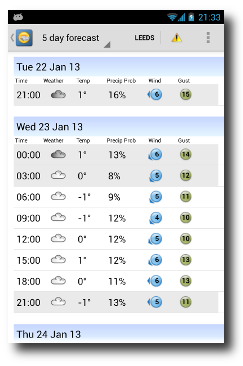
|
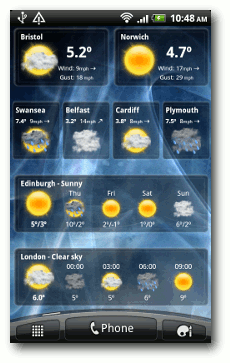
|
Weather Forecast: UK displays the highest quality UK weather forecast data available sourced directly from the Met Office. Get right to the detail you want to see quickly. Customise your data just how you want to see it. This application aims to be fast and easy to use.
Problems? Have feedback to share? You can email me at chris@onjara.com.
Features:
- Five day detailed forecast in 3 hour time intervals
- Forecast radar maps for rainfall, temperature, cloud cover and combined cloud and rain
- Charts and graphs of the weather forecast for different visualizations
- Detailed mountain specific forecast for 7 different mountain regions
- Surface pressure chart stretching from mid-Atlantic to Eastern Europe
- Met Office severe weather warnings integrated into application and widgets
- 3 sizes of home screen widgets available
- Fully and individually customisable units
- Textual forecast for up to 30 days
- Latest observation data from official Met Office observation locations
- Fast easy switching between multiple locations with recent location history
- Sunrise/Sunset times
- Configurable display of data - show only what you want
- Move to SD Card option
- Tablet friendly
Note: Though this application uses Met Office data, it is not an official Met Office application and the author has no affiliation or involvement with the Met Office. The author is very grateful for the public availability of this data.
Understanding the Application
Table of contents
- How to install the widgets
- Using the app for the first time
- The location button
- The display button
- Five day forecast view
- Textual forecast view
- Charts view
- Mountain forecast view
- Severe Weather Warnings view
- Observations view
- Maps view
- Understanding the application menu
- Understanding widgets
- Moving the application to the SD card
- Units of measurement and map data key
Installing widgets
A common question from users is how to install the widgets that come with the application. How you install widgets on your device depends on which operating system (OS) version you are on. Not sure which version you are on? Go to Settings->About Phone->Software Information. Your OS version is found under 'Android version'.
If you are on Honeycomb or earlier (i.e. OS version is less than 4.0) then do the following:
Find a home screen with space on it for your widget (swipe left or right from the main home screen if the main screen has no space left). A small widget requires the same space as 1 icon, the medium widget requires 2 icon spaces and the large widget requires 4 icon spaces (all horizontally). Once you've located your space, press and hold the screen at that space. A menu should pop up. 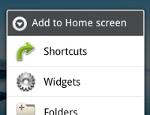 Depending again on your device's manufacturer what you see may be slightly different, but there should be an option to add a widget. On my device, it is listed as 'Widget' under 'Add items to Home'. Scroll to the bottom of the list of widgets which appear and look for 'Weather Forecast: UK (Large/Medium/Small)' and choose the size you wish.
Depending again on your device's manufacturer what you see may be slightly different, but there should be an option to add a widget. On my device, it is listed as 'Widget' under 'Add items to Home'. Scroll to the bottom of the list of widgets which appear and look for 'Weather Forecast: UK (Large/Medium/Small)' and choose the size you wish.
If you are on Ice Cream Sandwich or newer (i.e. OS version is equal or higher than 4.0) then do the following:
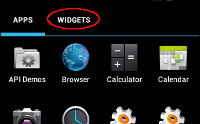 Open the app drawer (the place where all your application icons are). Select the 'widgets' tab at the top of the screen and scroll down/over to Weather Forecast:UK small/1x1, medium/2x1 or large/4x1. Press and hold the widget you want and drag it onto your homescreen where you want to put it.
Open the app drawer (the place where all your application icons are). Select the 'widgets' tab at the top of the screen and scroll down/over to Weather Forecast:UK small/1x1, medium/2x1 or large/4x1. Press and hold the widget you want and drag it onto your homescreen where you want to put it.
I followed the above instructions but still can't see the widgets
Some users have reported that though the above instructions work for them, this application's widgets don't appear in the list of widgets to choose from. Starting with newer versions of the Android operating system, the application must be launched at least once for the widgets to appear in the list. The other common cause of widgets not appearing in the list is that the application has been installed to the SD card. Home screen widgets are not compatible with any application installed on the SD card and this is a restriction of the Android operating system applicable to all apps. The easy fix is to move the application back to internal memory. See also Move to SD card below.
From here it should be self explanatory, but let me know if you have any issues.
First time use
When used for the very first time, the application will use your approximate location to choose the nearest Met Office weather forecast location. If you have location services turned off, the default location of London is used. The first screen shown is the 5 day forecast. Scroll up/down to see the other days forecast, and swipe left/right if your data spills off the side screen. Forecast data is refreshed at minimum intervals of two hours, unless a manual refresh is preformed (see menu options below). At the top is your action/information bar. This shows, from left to right, the application icon, display chooser, chosen location, weather warnings (if any) and menu launcher (shown as three vertical dots and only if using Android 4.0+).
Understanding locations

 The current location is shown in the action bar at the top of the screen. Pressing this ("Leeds" in this case) will open the location side bar (shown at right). Alternatively, you can press the application icon or drag your finger from the far left of the screen to the middle to 'catch' and drag open the sidebar. To close the side bar, either press the application icon button again, tap anywhere in the application window which has been shifted towards the right or press and hold and drag the application window back to the left. In the sidebar, you will find a history of recent locations viewed (with most recently viewed at the top of the list). You can select one of these to quickly change to this locations forecast. Alternatively, you can choose a new location. Also shown is the current conditions for the currently selected location, the sunrise/sunset times for this location, when the forecast was last updated (e.g. fecthed from the Met Office) and when the Met Office issued the forecast (when available). Within this view you can also remove individual locations from your recent locations list
The current location is shown in the action bar at the top of the screen. Pressing this ("Leeds" in this case) will open the location side bar (shown at right). Alternatively, you can press the application icon or drag your finger from the far left of the screen to the middle to 'catch' and drag open the sidebar. To close the side bar, either press the application icon button again, tap anywhere in the application window which has been shifted towards the right or press and hold and drag the application window back to the left. In the sidebar, you will find a history of recent locations viewed (with most recently viewed at the top of the list). You can select one of these to quickly change to this locations forecast. Alternatively, you can choose a new location. Also shown is the current conditions for the currently selected location, the sunrise/sunset times for this location, when the forecast was last updated (e.g. fecthed from the Met Office) and when the Met Office issued the forecast (when available). Within this view you can also remove individual locations from your recent locations list
The display button

This button is labelled with the current view. Press this to see other view options.
Five Day Forecast View
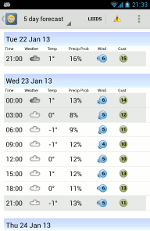 |
This view shows the five day forecast for the current location. If there are more data columns that the screen is able to show, then simply swipe left to scroll to the next horizontal page of data (i.e. see the additional columns). The columns which are displayed is configurable. See Understanding the application menu |
Textual View
This view shows a textual forecast provided by the Met Office. It is broken down into "Day 1 to 2", "Day 3 to 5", "Day 6 to 15" and "Day 16 to 30". When first viewed you are looking at the "Day 1 to 2" view. To see the other days views, you can either swipe left or right to move through the views or select any of the tabs at the top of the screen (under the action/location bar). If the tab you want is off the screen, the tab bar itself horizontally scrolls. Textual forecasts are based on the region the current forecast location is in and not specific to the exact location. E.g. For a current forecast location of Edinburgh, the textual forecast will be shown for Lothian and the Borders region. The exception to this is day 6 and beyond which shows the overall UK outlook. |
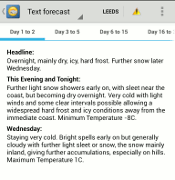 |
Charts View
This view shows a graphical display of all weather forecast data for the current location. Effectively, every available column for display in the 5 day forecast has been made into a graph or chart. Like the textual forecast view, you can move between charts by swiping left or right. Alternatively, you can select one of the tabs at the top of the screen (under the action/location bar). If the tabs spill off the screen you can horizontally scroll to see the other choices. For each chart/graph you have 3 viewing options. '5 day' shows the 5 day view for this chart. '24 hours' is the same as 5 day but only shows data for the next 24 hours. '5 Day summary' shows the high and low value for each day over the 5 days. |
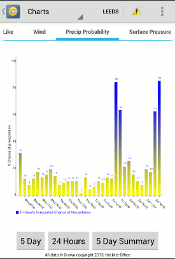 |
Mountain View
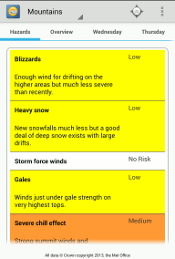 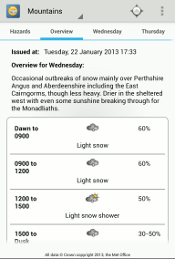 |
Warnings View
|
Observations View
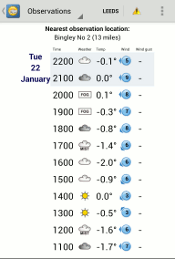 |
The Met Office have a host of observation locations across the UK which measure real weather data. This view shows the closest observation location to the current forecast location. Also shown is the approximate distance in miles of the observation location from the forecast location. Note that there are many more forecast locations than observation locations. Shown in the table are the actual observations over the last 24 hours. Note that not all observation locations are equal in terms of what data they provide. Therefore, for example, an observation location may show data for wind speed whilst another may not. |
Maps View
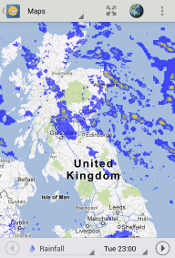 |
The maps view shows various observed and forecast imagry overlaid onto Google Maps. Forecast types available are:
Map supports pinch zooming (or you can use the zoom buttons). Click on the default 'Rainfall' button to change mode. Click on the date button to jump to a different observation or forecast time (only available in the premium version). You can also use the left/right arrows to step forwards and backwards in time. |
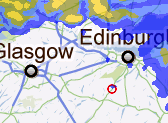 |
Your approximate location is shown on the map with a red circle. Your location is determined using network triangulation rather than GPS. While network location is less accurate than GPS, it is much more kind on your battery and given the resolutions involved the accuracy provided by GPS isn't necessary. |
 Press this globe icon to switch between satellite terrain mode and normal map mode. Satellite mode is most useful for viewing cloud cover which shows a good contrast of the clouds and green earth. Choose the arrows icon to recentre the map on a UK wide overview. |
|
The menu
Pressing the phone's menu key on any of the views will present the user with these options at a minimum:
- Settings: Configure the application to your needs
- About: See the application version and send an email to the developer
- Help: Opens this page in a browser
The following options are available in any forecast view (5-day, textual, charts or observations)
- Refresh: Force the application to refresh the forecast and weather warnings data. Textual forecast and observations data will also be refreshed if those views are currently displayed.
The following options are available in maps view
- Reload Map: Force the application to refresh all map data from scratch
Settings menu item
This menu allows you to configure the display of the application. Specifically, you can configure which columns appear in the weather forecast table, which columns appear in the observations table, configure weather warnings preferences and locations preferences
Location preferences sub menu
There are two options currently supported.
The first allows you to clear out any location information, removing all recent locations from your list. Only your current location is retained. The second option allows you to configure how many locations are saved in the history list (up to 20).
Weather warnings preferences sub menu
There is one option currently supported.
'Add warning icon to widgets', determines if you wish to show a warning triangle icon on your widget (in the lower left corner) if the forecast location for that widget has active weather warnings.
Map preferences sub menu
There are two options currently supported.
Untick 'Show current location' to hide the red circle on the maps view which denotes your current location.
The 'Cache size' option allows you to have control over how much data the maps cache. Caching is essentially saving in memory map tiles which aren't currently displayed on the screen. If you move back to a previous portion of the map, and that tile is in the cache, then it doesn't have to be reloaded. Caching is particularly effective when you step back and forth between timesteps to see movement of rainfall, for example, over time. If enough tiles are cached, then this stepping back and forth is near instant, whereas otherwise tiles need to be loaded again from the network. The downside to caching is that it takes up a lot of memory which not all devices have. If you do lots of stepping back and forth, choose a larger cache size. If your device is low on memory, switch to a lower cache setting or turn it off alltogether. If you choose a cache setting to high, your device will run out of memory. The application is built to attempt to recover from such situations by clearing out the cache and temporarily disabling the cache. If you recieve a message about such an occurance (e.g. being dangerously low on memory) then you should reduce the cache size to improve your user experience and avoid crashes.
Widget preferences sub menu
There are three options currently supported.
Choose 'Widget update frequency' to customize how often the widget will perform an update or turn off updates all-together if you wish.
'Wake up device for updates' will allow the device to wake up, if asleep, perform the update and then go back to sleep. Note that if other processes wake up the phone and the widget is due an update it will still take advantage of the wake-up state to perform its update.
'Remove widget background' allows you to have a completely transparent widget
Unit preferences sub menu
From here you can modify the units of data and see explanations of others. See units below for your choices.
Widgets
See also 'How do I install these widgets?'
The application includes four widgets to choose from (the 'large' 4x1 widget and 'x-large' 4x2 widgets are available in the paid version only). Sizes supported are small (1x1), medium (2x1), large (4x1) and x-large (4x2)*:
| 1x1 | 
|
| 2x1 | 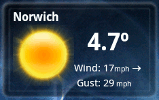
|
| 4x1 five day forecast | 
|
| 4x1 next hours forecast | 
|
| 4x2 five day forecast (also available as 'next hours' forecast) | 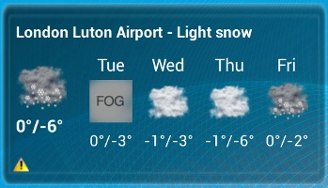
|
* - Note the actual number of cells the widget takes up on the home screen can vary from device to device.
The widgets will show the most recent forecast data for the location for the current time. The large (4x1) and x-large (4x2) widgets can also show the 5 day summary forecast with single day weather image and high/low temperatures for that day. Clicking on the widget will launch the full application changing the location to the widgets location (if necessary). You can setup multiple widgets for multiple locations.
Also available on the large and x-large widgets is the ability to resize horizontally (only available on Android 3.1+). To resize a widget, press and hold the widget to 'pick' it up. Then let go to 'drop' it back in place. This will bring up a blue band around the widget with two handles on the left and right of the widget. Drag a handle to expand (or contract) the widget. These widgets do not expand vertically and cannot shrink more than the initial layout.
When there is an active weather warning for your widgets location, a triangle warning icon (in yellow, amber or red) will appear to notify you of this. This is configurable in the options menu of the applicaiton if you do not desire this behaviour. Here's what it looks like:
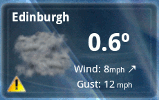
Move to SD Card option
The application aims to be small for its type. However, you still may have the wish to move the application to your SD card to free up internal phone storage space. To move the application to the SD card, from the home screen (not the application!) select Menu->Settings->Applications->Manage Applications. Scroll down to and click on Weather Forecast UK. Click on the 'Move to SD card'.
Please note, moving any application (including this one) to your phone's SD card disables some functionality in the application such as services or widgets. For Weather Forecast: UK, moving it to the SD card will prevent you from being able to use the included widgets. This is a restriction of the Android operating system and something which developers have no control over. However, launching the application from the icon will not behave any differently on the SD card vs internal phone storage. Only widgets are effected. If after moving to the SD card you miss the widgets functionality, you can move it back to your phone via Menu->Settings->Applicaitons->Manage Applications->Weather Forecast UK->'Move to phone'
Units
Units options are as follows:
| Wind gust/speed | miles per hour (mph), kilometres per hour (kph), metres per second (m/s), knots (knots) or Beaufort (force) |
| Temperature | degrees Celsius (C) or Fahrenheit (F) |
| Visibility | kilometres (km), metres (m), miles (mi), feet (ft) or descriptive text |
| Humidity | % |
| UV | solar UV index (1-2=low, 3-5=moderate, 6-7=high, 8-10=very high, 11+=extreme) |
| Pressure | hectopascal (hPa), millibar (mb), inches Mercury (in Hg) or millimetres Mecury (mm Hg) |
Icons: For a complete list of Met Office weather icons and their descriptions, please see the Met Office weather symbol guide
.Rainfall Key:
- 0.01 - 0.5
- 0.5 - 1
- 1 - 2
- 2 - 4
- 4 - 8
- 8 - 16
- 16 - 32
- > 32
Rainfall in mm / hour
Temperature Key:
- -30
- -28
- -26
- -24
- -22
- -20
- -18
- -16
- -14
- -12
- -10
- -8
- -6
- -4
- -2
- 0
- 2
- 4
- 6
- 8
- 10
- 12
- 14
- 16
- 18
- 20
- 22
- 24
- 26
- 28
- 30
- 32
- 34
- 36
degrees Celsius
Problems? Have feedback to share? You can email me at chris@onjara.com.


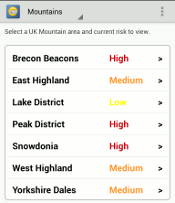 This view shows mountain specific forecasts. As the forecast for a mountain area is often dramatically different than for settled areas they truly deserve their own forecast. Available are forecasts for 7 different mountain regions within the UK. Initially shown is the list of areas to choose from and the current overall risk associated with that area. Selecting a region will drill down into the detailed forecast for that area. Within the detailed forecast are a number of different tabs of data which you can swipe left and right between, showing a list of hazards for that area, the overview forecast for the next 24 hours, and textual forecasts for today and the next few days. Pressing the location icon in the action/location bar takes you back to the mountain area list page.
This view shows mountain specific forecasts. As the forecast for a mountain area is often dramatically different than for settled areas they truly deserve their own forecast. Available are forecasts for 7 different mountain regions within the UK. Initially shown is the list of areas to choose from and the current overall risk associated with that area. Selecting a region will drill down into the detailed forecast for that area. Within the detailed forecast are a number of different tabs of data which you can swipe left and right between, showing a list of hazards for that area, the overview forecast for the next 24 hours, and textual forecasts for today and the next few days. Pressing the location icon in the action/location bar takes you back to the mountain area list page.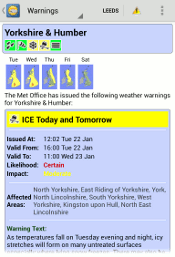 This view shows severe weather warnings for the region of your current location. Along the top is a summary of warnings which the Met Office report on location under the region
This view shows severe weather warnings for the region of your current location. Along the top is a summary of warnings which the Met Office report on location under the region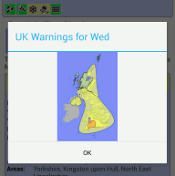 name. For each summary warning, a coloured icon is used to show the most severe warning for the period. Under this are a series of day by day images showing an overall UK maps and the extent of the weather warnings. Clicking on an individual day will enlarge that days image (see right). When a single warning type is in effect (e.g. only snow) then that icon is shown in the action/location bar. However, if multiple warnings are present (snow and ice in this screenshot) then a generic warning icon of the most severe colour is shown instead.
name. For each summary warning, a coloured icon is used to show the most severe warning for the period. Under this are a series of day by day images showing an overall UK maps and the extent of the weather warnings. Clicking on an individual day will enlarge that days image (see right). When a single warning type is in effect (e.g. only snow) then that icon is shown in the action/location bar. However, if multiple warnings are present (snow and ice in this screenshot) then a generic warning icon of the most severe colour is shown instead.